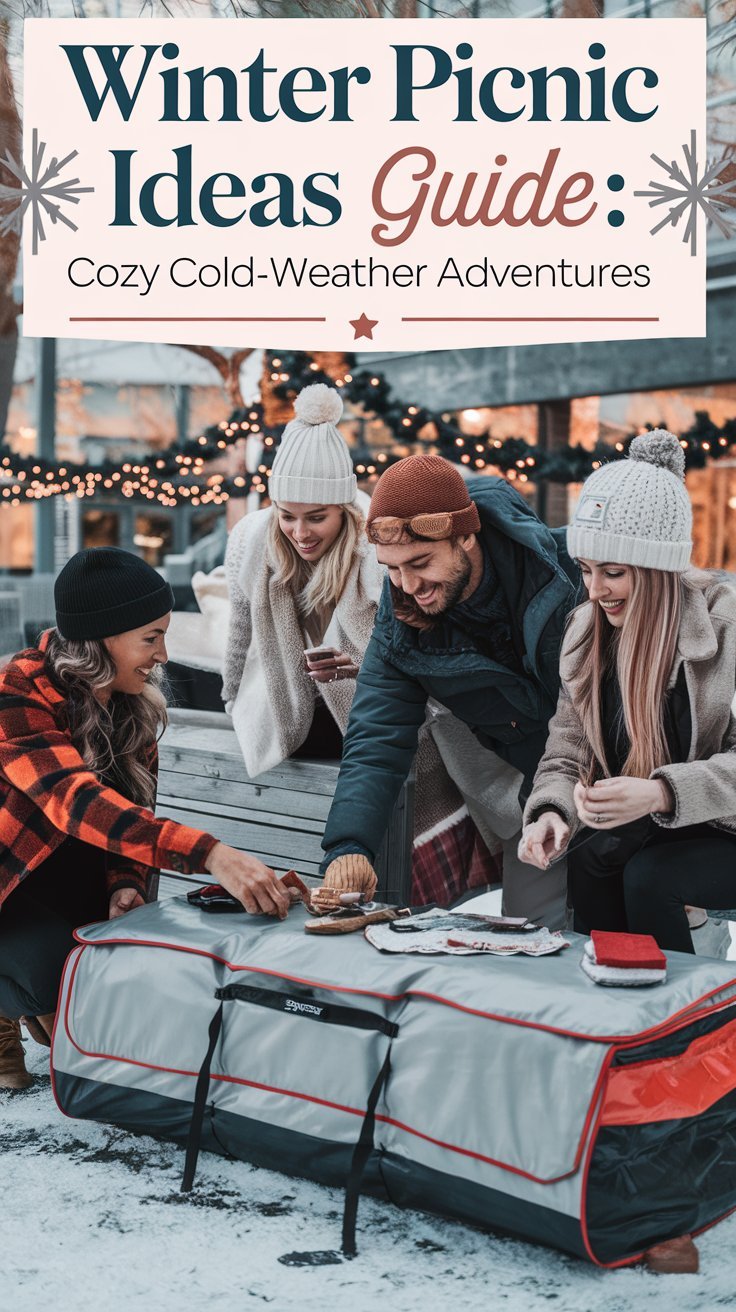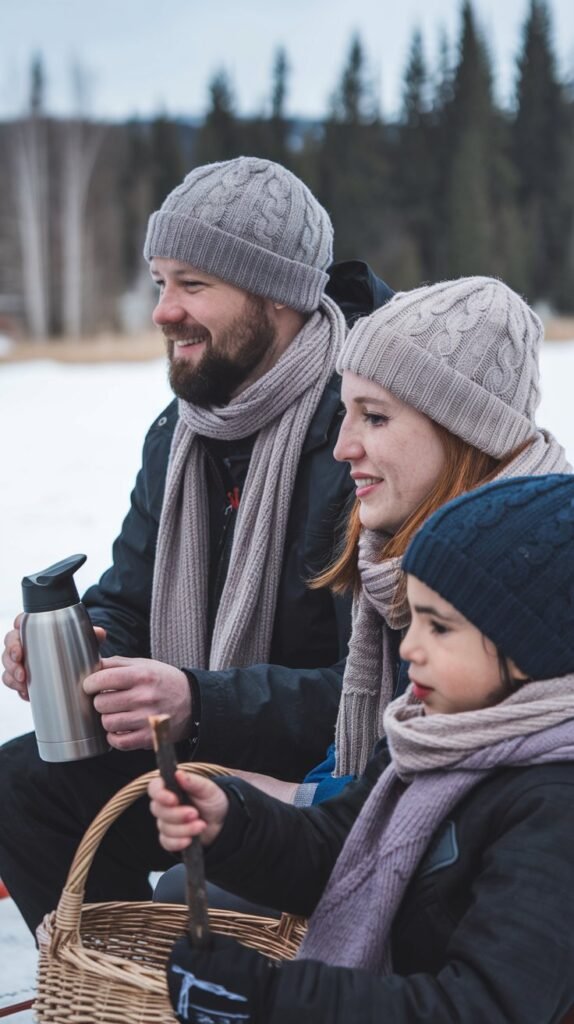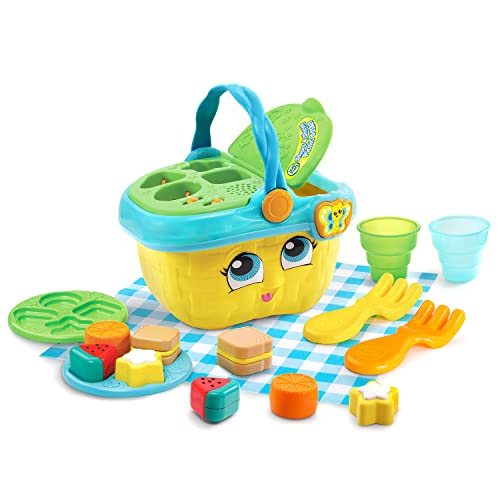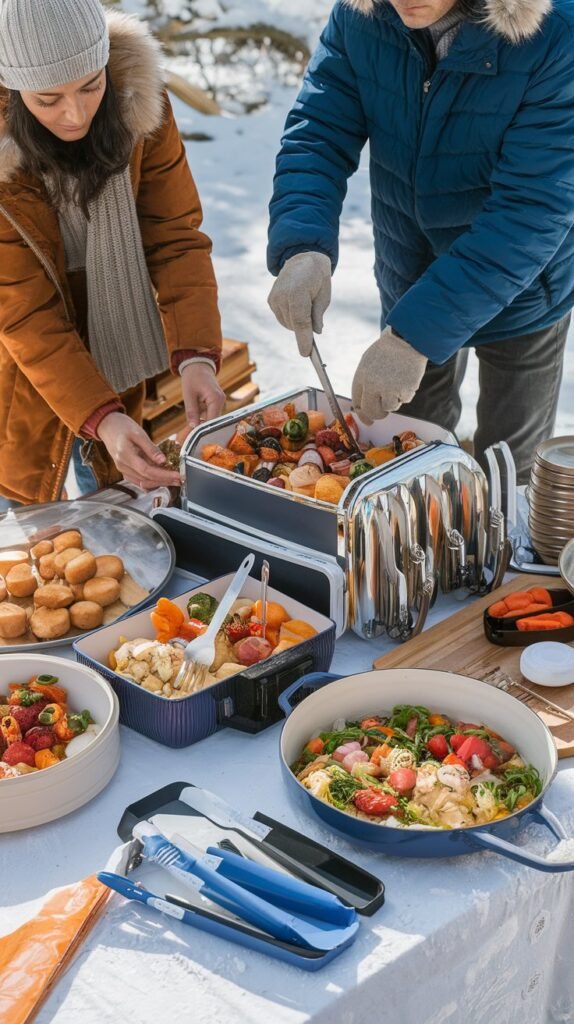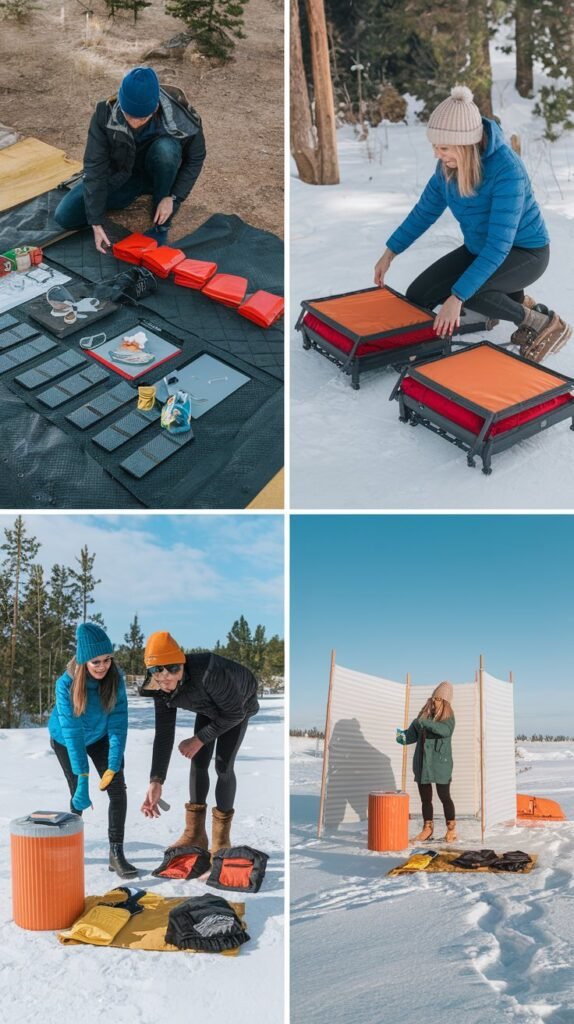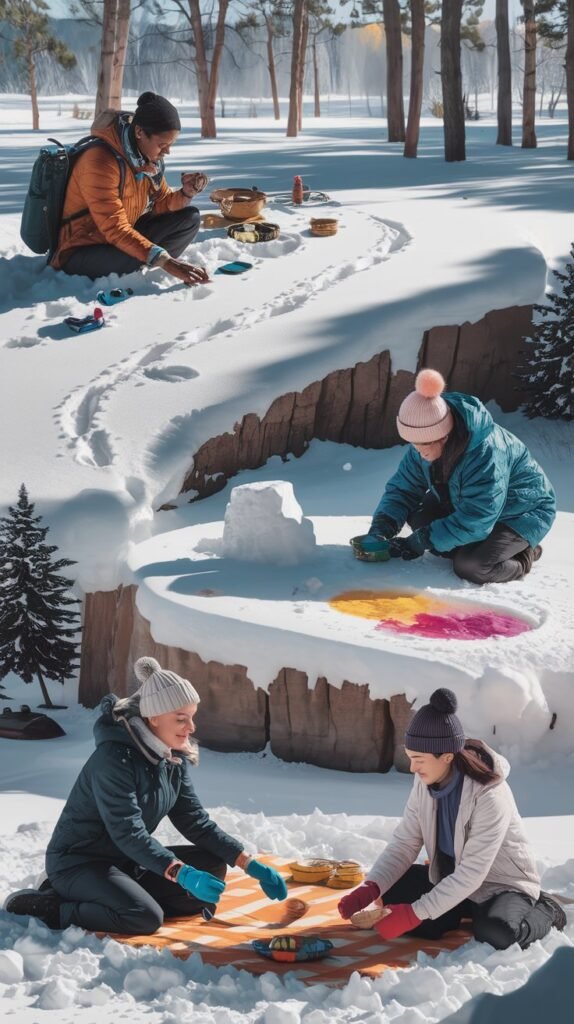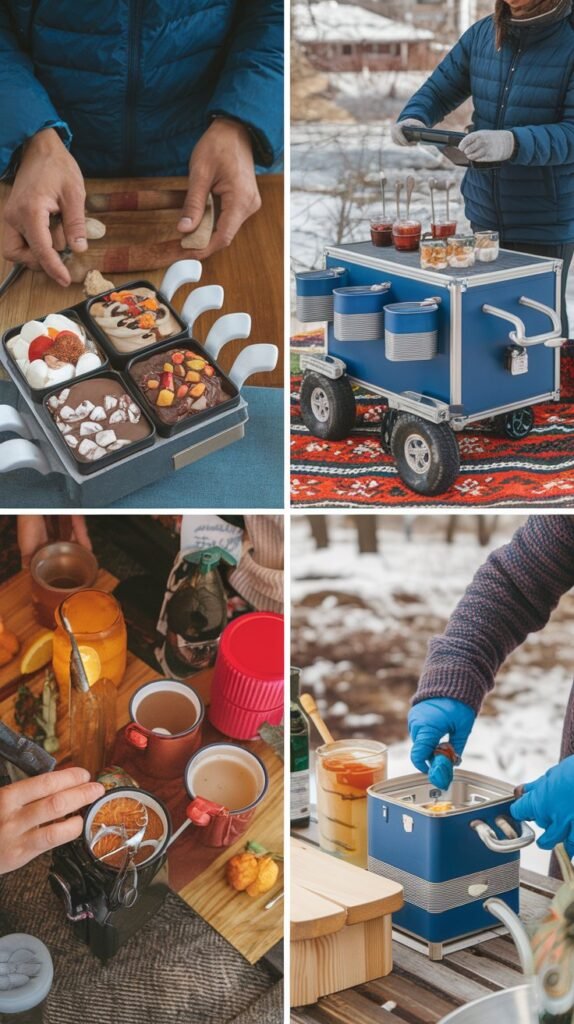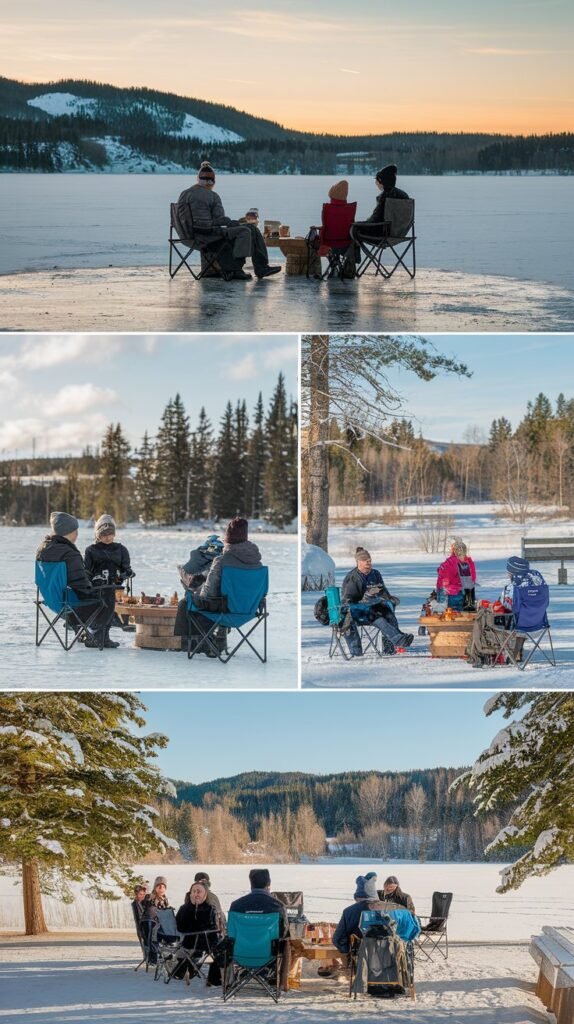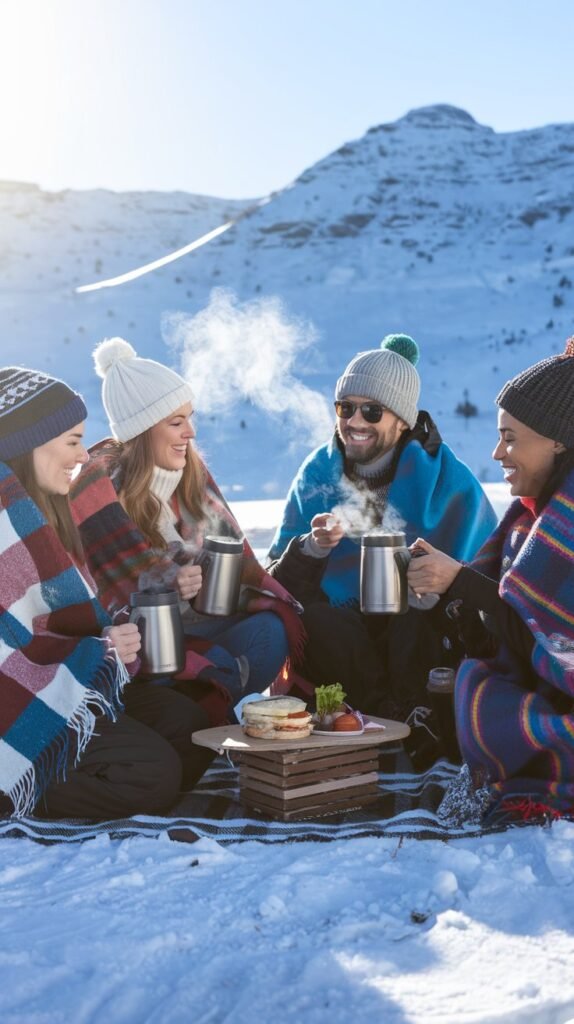Winter picnics offer a magically unexpected twist on outdoor dining, combining the crisp exhilaration of cold-weather exploration with the heartwarming comfort of seasonal treats. These invigorating celebrations bring together temperature-conscious cuisine, strategic warmth-preserving equipment, and seasonal accompaniments in settings that transform ordinary snow-covered parks, frosted landscapes, or sunny winter days into extraordinary dining adventures that awaken the senses and create memorable cold-season connections.
Let’s explore how to create the perfect winter picnic that balances the magical beauty of cold-weather settings with practical outdoor entertaining success!
Winter Picnic Planning Fundamentals
Establish the perfect foundation for your cold-weather celebration.
Understanding Modern Winter Picnic Approaches
Creating magical yet practical cold-weather dining experiences:
- Temperature Management Priority: Heat retention for both food and people
- Duration Consideration Focus: Appropriate timeframes for comfort
- Weather Monitoring Strategy: Selecting ideal conditions within winter
- Shelter Identification: Wind protection and sun exposure maximization
- Insulation Layer Planning: Ground separation and cold barrier creation
- Mobility Maintenance: Appropriate clothing for freedom of movement
- Seasonal Atmosphere Enhancement: Winter-specific beauty maximization
“Winter picnics require a thoughtful balance between seasonal magic and practical comfort considerations,” shares Crystal, who specializes in cold-weather gatherings. “We approach these events with what we call ‘strategic warmth’—carefully planning every element to maintain comfort while embracing winter’s unique beauty. The most successful winter picnics focus on shorter durations than summer equivalents, locations with natural wind protection and maximum sun exposure, and specialized equipment that creates genuine comfort despite cold conditions. When properly executed, winter picnics offer sensory experiences impossible in warmer months—the particular quality of winter light, the pristine quiet of snow-covered landscapes, and the heightened appreciation of warm food and drink that only cold weather can bring.”
Location Selection Strategy
Finding the perfect setting for winter picnic enjoyment:
- Sun Exposure Maximization: Locations with unobstructed southern exposure
- Wind Protection Assessment: Natural barriers or structural shelter
- Snow Condition Evaluation: Appropriate surfaces or clearing possibilities
- Seating Consideration: Available benches or portable alternatives
- Accessibility Analysis: Winter travel and parking feasibility
- Shelter Proximity Planning: Warming options if needed
- Scenic Winter Element Integration: Features enhanced by snow or frost
“Selecting the right location creates the essential foundation for winter picnic success,” explains Frost, who plans diverse outdoor gatherings. “We’ve found the most effective approach is what we call ‘microclimate identification’—finding spots that naturally maintain warmer temperatures despite winter conditions. We particularly recommend seeking locations with southern exposure that receive maximum winter sunlight, natural windbreaks like dense evergreen stands or rock formations, and ideally some form of seating that eliminates ground contact. Urban parks often offer ideal infrastructure with sun-exposed benches and wind-blocking structures, while natural areas may provide more pristine winter beauty but require additional comfort planning. The perfect winter picnic spot feels noticeably warmer than surrounding areas while showcasing winter’s special aesthetic qualities.”
Weather Selection Strategy
Identifying ideal winter days for outdoor dining comfort:
- Temperature Range Focus: Finding mild winter day opportunities
- Wind Factor Prioritization: Calm conditions over absolute temperature
- Sunshine Requirement: Clear skies for both warmth and atmosphere
- Recent Precipitation Consideration: Fresh snow beauty versus practicality
- Weather Trend Analysis: Rising versus falling temperature timing
- Time-of-Day Optimization: Peak warmth period identification
- Backup Plan Integration: Alternative date or indoor option availability
“Winter picnic weather selection requires specialized techniques that address the unique challenges of cold-season outdoor dining,” shares Evergreen, who specializes in seasonal experiences. “We develop what we call ‘comfort windows’—strategic identification of optimal conditions within winter’s variability. We generally recommend prioritizing wind conditions over absolute temperature, as a 30°F calm day can feel more comfortable than a 40°F windy one, watching for those unusual winter warm spells that periodically offer surprisingly mild conditions, and focusing on mid-day hours when sun angle creates maximum warming. Planning weekends with multiple weather-contingent options allows flexibility to select the ideal day as forecasts become more reliable, while preparation for a range of conditions ensures comfort even if predictions aren’t perfect.”
Winter Picnic Food
Cold-weather cuisine designed for seasonal enjoyment.
Winter picnic cuisine focuses on varieties that maintain heat during serving while delivering comforting flavors that enhance the cold-weather experience. The ideal approach prioritizes heat-retention, simplified serving that minimizes exposure, and complementary items that maintain quality despite temperature challenges.
| Heat-Retaining Main Dishes | Cold-Resistant Sides | Winter-Friendly Finger Foods | Temperature-Stable Desserts |
|---|---|---|---|
| Hearty Soup in Thermoses | Winter Fruit Salad | Cheese & Charcuterie Board | Chocolate Brownies |
| Chili or Stew | Grain-Based Salads | Stuffed Baked Apples | Cranberry Orange Cookies |
| Hot Sandwiches in Foil | Roasted Winter Vegetables | Savory Hand Pies | Spiced Nuts |
| Baked Pasta in Insulated Container | Potato Salad | Bacon-Wrapped Dates | Gingerbread Squares |
| Hearty Quiche Slices | Bean Salads | Smoked Salmon Bites | Winter Fruit Bars |
| Savory Bread Pudding | Roasted Beet Salad | Meatballs with Dipping Sauce | Dark Chocolate Bark |
| Stuffed Baked Potatoes | Winter Slaw | Stuffed Mushrooms | Oatmeal Cookies |
| Warm Grain Bowls | Marinated Vegetable Medley | Pigs in Blankets | Spiced Cake Squares |
Creating Winter Picnic Food Successfully
Techniques for warm, satisfying cold-weather dining:
- Heat Retention Priority: Foods that maintain temperature naturally
- Thermal Container Utilization: Appropriate vessels for temperature maintenance
- Pre-Heating Strategy: Warming containers before filling
- Layering Technique Focus: Insulation for extended warmth
- Serving Minimization Approach: Reducing exposure during consumption
- Portion Planning Consideration: Appropriate sizing for quick enjoyment
- Flavor Enhancement: Seasonal spices and warming ingredients
“I approach winter picnic food with what I call ‘comfort engineering’—creating cuisine that solves cold-weather challenges while delivering seasonally appropriate satisfaction,” shares Juniper, who specializes in winter cuisine. “We emphasize selecting varieties with natural heat-retention properties like thick soups, stews and chilis, using double-insulated containers pre-heated with boiling water before filling, and focusing on foods that taste wonderful even as they cool to moderate temperatures. We particularly recommend incorporating warming spices that psychologically enhance heat perception—cinnamon, ginger, cloves, and chili pepper—while ensuring hand-friendly portions that can be consumed without prolonged exposure. The ideal winter picnic menu balances practical temperature considerations with seasonal celebration—perhaps featuring ingredients unique to winter like citrus fruits, root vegetables, and warming spices that create an experience that actually embraces rather than merely tolerates the season.”
Winter Picnic Comfort
Essential strategies for maintaining physical enjoyment in cold settings.
Insulation Strategy Development
Creating critical separation from cold surfaces:
- Multi-Layer Foundation Priority: Building effective thermal barriers
- Moisture Barrier Integration: Preventing ground dampness transmission
- Seated Elevation Focus: Minimizing direct cold transfer
- Thermal Material Selection: Appropriate fabrics and materials
- Compact Packability Balance: Effectiveness versus transport practicality
- Setup Efficiency Consideration: Quick deployment in cold conditions
- Adaption for Various Settings: Solutions for snow, benches, and cleared areas
“I approach winter picnic insulation with what we call ‘thermal architecture’—creating structured protection systems rather than mere layers,” explains Aurora, who designs cold-weather outdoor experiences. “We begin with a completely waterproof ground layer using materials like tarp or waterproof blankets, add a second layer of closed-cell foam pads that block conductive heat loss, and finish with comfortable insulated blankets or sheepskins that provide both warmth and softness. For snowy conditions, compacting snow before laying your foundation actually improves stability while creating an air-trapping effect. The most successful winter picnic setups prioritize keeping your body from direct contact with cold surfaces through portable stadium seats, padded cushions, or even specialized winter-ready furniture with thermal barriers built into their design.”
Layered Clothing Management
Personal temperature regulation for outdoor comfort:
- Base Layer Technology Focus: Moisture-wicking foundation garments
- Mid-Layer Insulation Strategy: Trapped air for thermal efficiency
- Outer Layer Protection Consideration: Wind and moisture barriers
- Extremity Prioritization: Enhanced protection for hands, feet, head
- Adjustability Integration: Options for temperature regulation
- Activity Level Adaptation: Appropriate insulation for picnic stillness
- Material Selection Expertise: Natural and synthetic appropriate choices
“Effective winter picnic clothing requires a systematic approach that addresses the specific challenges of relatively stationary outdoor dining,” shares Nordic, who specializes in cold-weather comfort. “We develop what we call ‘picnic-specific layering’—creating warmth systems that acknowledge you’ll be less active than during winter sports yet still need complete comfort. We recommend building around the classic three-layer system—a moisture-wicking base that keeps perspiration away from skin, an insulating mid-layer that traps warm air, and a wind/water-resistant outer shell—while emphasizing extremity protection often overlooked in casual winter outings. The most successful winter picnic attire includes seemingly small elements with disproportionate comfort impact: insulated sitting pads that tuck into clothing, chemical hand warmers strategically placed near wrists where they warm blood flow, and insulated mugs that warm hands while you drink.”
Microclimate Engineering
Creating protected spaces within winter environments:
- Wind Barrier Priority: Strategic blocking of primary heat-depleting force
- Reflected Heat Utilization: Surface positioning to capture solar gain
- Portable Shelter Consideration: Lightweight weather protection options
- Natural Feature Integration: Using landscape elements advantageously
- Group Configuration Strategy: Body heat conservation through proximity
- Duration Management Focus: Appropriate timeframes for maintained comfort
- Psychological Comfort Enhancement: Creating perception of greater warmth
“Winter picnic comfort relies heavily on understanding and manipulating microclimate dynamics to create protected pockets within broader winter conditions,” explains Alpine, who studies environmental adaptation. “We focus on what we call ‘intentional microclimate’—strategically modifying your immediate surroundings to dramatically improve comfort. This begins with identifying and blocking the prevailing wind direction using natural features, temporary windscreens, or even strategic backpack placement, continues with positioning seating to maximize direct sunlight exposure and reflected heat from surfaces like rock walls or south-facing structures, and extends to social arrangements that actually leverage collective body heat. The physical difference between an exposed winter location and a protected microclimate can represent a 10-15°F practical temperature improvement, transforming a challenging experience into a completely comfortable one through purely strategic arrangements.”
Winter Picnic Activities
Engaging entertainment that enhances your cold-weather experience.
Winter-specific activities create memorable engagement opportunities beyond just dining, transforming your cold-weather picnic into an immersive seasonal experience. The ideal approach incorporates elements that celebrate winter’s unique properties, maintain comfortable body temperature through appropriate movement, and connect authentically with the special qualities of the season in engaging, creative ways.
| Snow-Based Activities | Winter Nature Connection | Warming Movement Options | Seasonal Atmospheric Elements |
|---|---|---|---|
| Snowman Building | Animal Track Identification | Winter Dancing | Twinkling Light Display |
| Snow Angels | Frost Pattern Photography | Snowball Target Practice | Battery-Powered Candles |
| Snow Art Creation | Winter Bird Watching | Winter Scavenger Hunt | Seasonal Music |
| Igloo Construction | Tree Identification | Shuttle Runs Between Trees | Evergreen Decorations |
| Snow Sculpture Contest | Tracking Stories | Partner Movement Games | Seasonal Hot Beverages |
| Colored Ice Building | Ice Formation Observation | Cold-Weather Yoga | Winter Storytelling |
| Snow Maze Creation | Winter Plant Identification | Hot Potato Variations | Stargazing (Early Darkness) |
| Snowball Fight | Winter Sky Watching | Follow-the-Leader Movements | Season-Specific Readings |
Creating Engaging Winter Picnic Activities
Techniques for meaningful seasonal engagement in cold settings:
- Temperature Maintenance Priority: Activities that generate warmth
- Winter-Specific Focus: Experiences uniquely possible in cold seasons
- Equipment Minimization Strategy: Simplicity for cold-weather handling
- Duration Consideration: Appropriate timing for comfort maintenance
- Physical Comfort Balance: Movement without overheating/sweating
- Seasonal Element Celebration: Activities that highlight winter’s gifts
- Accessibility Enhancement: Options for various physical abilities
“I approach winter picnic activities with what I call ‘seasonal specificity’—creating engaging experiences that actually require or celebrate winter conditions rather than merely tolerating them,” shares Crystal, who specializes in seasonal events. “We emphasize selecting activities that would be impossible in warmer months, from snow sculpture creation to animal track identification only visible on snow surfaces to the unique photography opportunities presented by winter light and ice formations. We particularly recommend incorporating at least one activity specifically designed to maintain comfortable body temperature—perhaps a winter scavenger hunt that encourages movement, a simple snowball target game that keeps arms active, or even winter-adapted yoga poses that maintain circulation while celebrating the season. The most successful winter picnic activities transform potentially challenging conditions into unique seasonal gifts.”
Winter Picnic Beverages
Warming sips that enhance your cold-weather dining experience.
Winter picnic beverages should prioritize heat retention while delivering seasonally appropriate flavors that enhance the cold-weather experience. The ideal approach creates warming, satisfying options that maintain temperature despite challenging conditions while incorporating flavors that celebrate winter’s unique seasonal offerings.
| Hot Chocolate Variations | Warming Tea Options | Seasonal Special Drinks | Heat Maintenance Techniques |
|---|---|---|---|
| Classic Hot Chocolate | Spiced Chai Tea | Mulled Apple Cider | Pre-Heated Containers |
| Mexican Spiced Cocoa | Ginger Tea | Hot Cranberry Punch | Double-Walled Vessels |
| White Chocolate | Earl Grey with Orange | Hot Vanilla Milk | Thermal Carafe Systems |
| Peppermint Hot Chocolate | Cinnamon Tea | Hot Buttered Cider | Insulated Cup Covers |
| Salted Caramel Cocoa | Cardamom Tea | Wassail | Thermal Wraps |
| Dark Chocolate Mocha | Rooibos with Vanilla | Spiced Almond Milk | Cup Koozies |
| Nutella Hot Chocolate | Herbal Chai | Winter Fruit Tea | Chemical Warmers |
| Hazelnut Cocoa | Lemon Ginger Tea | Hot Maple Milk | Layered Cup Insulation |
Creating Winter Picnic Beverages Successfully
Techniques for warming yet practical cold-weather drink service:
- Heat Retention Priority: Extended temperature maintenance systems
- Pre-Heating Strategy: Preparing vessels for maximum starting temperature
- Serving Consideration: Appropriate cups for heat maintenance
- Seasonal Flavor Enhancement: Winter-specific taste profiles
- Warming Ingredient Integration: Elements that enhance perceived warmth
- Portion Management Focus: Appropriate serving for extended enjoyment
- Temperature Monitoring: Preventing too-rapid cooling
“I approach winter picnic beverages with what I call ‘layered heat management’—offering genuinely hot drinks adapted for extended outdoor enjoyment,” shares Aspen, who develops specialized outdoor beverage programs. “We recommend focusing first on proper container pre-heating—filling thermal vessels with boiling water for several minutes before emptying and adding your actual beverage—which dramatically extends heat retention time. Preparing liquids slightly hotter than normal drinking temperature provides additional cooling buffer, while incorporating warming spices like cinnamon, ginger, and clove both enhances flavor and creates the perception of greater warmth through their thermogenic properties. The ideal approach includes thoughtful cup management—perhaps double-cup systems, insulated mugs with secure lids, or even cup wraps that provide additional insulation—while encouraging relatively quick consumption of small portions with opportunities for refills rather than allowing large servings to cool gradually.”
Creating the Perfect Winter Picnic Atmosphere
Transform your cold-weather space into a magical seasonal environment.
Visual Atmosphere Enhancement
Creating magical winter-specific ambiance:
- Natural Element Incorporation: Seasonal decorative components
- Lighting Strategy Priority: Warm illumination in winter darkness
- Color Palette Consideration: Visual warming through appropriate shades
- Contrast Enhancement Focus: Highlighting winter’s natural beauty
- Portable Display Development: Lightweight yet impactful visual elements
- Multiple Sense Engagement: Beyond visual to comprehensive experience
- Seasonal Specificity Integration: Winter-celebrating decorative choices
“Winter picnic atmosphere creates magical environments through thoughtful enhancement of the season’s natural beauty,” shares Aurora, who designs winter experiences. “We develop what we call ‘seasonal illumination’—focusing on the unique lighting opportunities winter provides. We emphasize portable battery-operated lighting options like small string lights, LED candles in glass containers, or even headlamps positioned to create ambient bounce lighting, all of which create disproportionate impact against winter’s early darkness. Natural elements gathered on-site or brought from home—pine cones, evergreen sprigs, colorful winter berries—create instant seasonal atmosphere without significant transport weight. The most successful winter picnic atmosphere celebrates rather than fights against the season, perhaps incorporating ice luminaries (frozen water in balloons with candles), highlighting frost patterns through strategic positioning, or creating simple snow lanterns by packing snow around flameless candles.”
Cozy Comfort Enhancement
Creating psychological warmth beyond physical temperature:
- Textile Selection Priority: Materials with visual and tactile warmth
- Aromatic Enhancement: Seasonal scents that suggest warmth
- Audio Atmosphere Development: Music creating emotional warmth
- Color Psychology Utilization: Warm tones that influence perception
- Gathering Organization: Proximity that enhances communal feeling
- Seasonal Tradition Integration: Cultural elements that evoke comfort
- Contrast Appreciation: Highlighting comfort against natural winter
“Winter picnic comfort goes beyond physical heat to incorporate psychological warmth created through multiple sensory channels,” explains Juniper, who studies seasonal psychology. “We focus on what we call ‘comprehensive coziness’—strategically influencing comfort perception through all available senses. This begins with visual elements like warm-toned blankets and textiles in reds, oranges and golds that psychologically signal warmth, continues with aromatic components like cinnamon sticks, pine, or cedar that trigger comfort associations, and extends to auditory elements like gentle seasonal music that completes the immersive experience. The most successful winter picnic atmospheres create the Danish concept of ‘hygge’—that indefinable sense of coziness, comfort and contentment—through deliberate attention to these seemingly small details that collectively transform mere temperature management into genuine winter celebration.”
Special Winter Picnic Variations
Adapt your approach for different seasonal occasions and settings.
Snow Sports Integration Picnics
Creating refreshing mid-activity refueling experiences:
- Activity Proximity Priority: Convenient access from recreational paths
- Simplified Setup Focus: Quick deployment and breakdown
- Energy Consideration: Appropriate refueling for cold-weather exertion
- Equipment Management Strategy: Securing recreational gear during dining
- Thermal Regulation Balance: Preventing overheating from activity
- Brief Duration Planning: Appropriate timeline to maintain momentum
- Multi-Purpose Gear Utilization: Recreational equipment as picnic infrastructure
“Snow sport picnics create perfect refreshment pauses that enhance rather than interrupt winter recreation,” explains Nordic, who plans outdoor winter experiences. “We approach these events with what we call ‘integrated refueling’—carefully linking dining with recreation logistics. We particularly recommend identifying natural scenic stops along cross-country ski trails, snowshoe paths, or sledding hills where minimal additional effort creates maximum experience enhancement. For particularly successful snow sport picnics, consider using activity equipment as picnic infrastructure—perhaps sleds as seating platforms, ski poles to create pack hangers, or snowshoes to compact seating areas in deep snow. The most successful approach maintains activity momentum by keeping the experience simple—perhaps just hot soup and sandwiches from thermoses enjoyed during a 20-minute scenic appreciation break—while ensuring the break genuinely enhances rather than merely interrupts the overall winter recreation experience.”
Winter Holiday Celebration Picnics
Creating meaningful outdoor seasonal gatherings:
- Cultural Tradition Integration: Holiday-specific elements and foods
- Festive Atmosphere Priority: Seasonal decoration and ambiance
- Gift Exchange Consideration: Weather-appropriate sharing activities
- Special Occasion Food Enhancement: Traditional holiday offerings
- Multi-Generation Comfort Focus: Inclusive experience for varied ages
- Ceremonial Element Inclusion: Meaningful holiday-specific activities
- Privacy versus Public Balance: Appropriate setting for celebration
“Winter holiday picnics offer extraordinary opportunities to experience traditional celebrations in fresh, memorable contexts,” shares Holly, who specializes in seasonal gatherings. “We develop what we call ‘tradition transplantation’—creating magical moments by moving indoor expectations into unexpected outdoor settings. We recommend selecting elements of traditional holiday celebrations that translate effectively outdoors—perhaps a lighting ceremony transported to a natural setting, traditional foods reimagined in thermos-friendly formats, or gift exchanges conducted around a specially decorated natural tree or feature. The most successful holiday picnics balance authentic tradition with practical adaptation—maintaining the emotional core of holiday celebrations while embracing the unique atmosphere winter outdoors provides. There’s something particularly magical about familiar holiday traditions experienced in fresh air with natural beauty that creates memories far more distinctive than their indoor counterparts.”
More Creative Winter Picnic Inspiration
Looking for additional cold-weather dining ideas? Here’s a collection of creative concepts!
| Winter Picnic Themes | Seasonal Activity Elements | Creative Warming Techniques | Atmosphere Enhancement Ideas |
|---|---|---|---|
| Winter Solstice Celebration | Ice Lantern Creation | Portable Fire Pit | Winter Constellation Map |
| Frost Appreciation Picnic | Snowflake Photography | Hand Warmer Exchange Game | Snow Globe Centerpieces |
| Winter Bird Watching | Heated Stone Massage | Hot Water Bottle Pass | Frozen Bubble Demonstration |
| Snow Moon Festival | Winter Scavenger Hunt | Warming Movement Games | Prism Ice Crystal Creation |
| Hygge Experience | Wildlife Tracking | Partner Warming Activities | Snowy Branch Decorations |
| Winter Tea Ceremony | Snow Shelter Building | Radiator Rock Heating | Lantern-Lit Snow Path |
| Ice Fishing Feast | Ice Crystal Study | Thermal Sitting Rocks | Colorful Winter Berry Display |
| Winter Foraging Experience | Snow Painting | Heated Blanket Station | Winter Shadow Photography |
Conclusion: Celebrating Connection Through Winter Wonderlands
Winter picnics create memorable outdoor gatherings through the perfect combination of seasonal beauty, strategic warmth management, and creatively designed environments that transform ordinary cold-weather settings into extraordinary dining adventures.
What makes winter picnics extraordinary is their ability to transform what many consider a challenging season into a uniquely magical dining experience, where familiar activities take on fresh significance through seasonal contrast and ordinary landscapes reveal unexpected beauty through frost, snow, and winter light. When thoughtfully planned with attention to both practical warmth management and meaningful seasonal celebration, these cold-weather gatherings offer uniquely effective opportunities for creating memorable connections during months often spent primarily indoors.
So prepare your insulated picnic blanket, pack your thermal food containers and hot beverages, and choose your perfect winter location for an afternoon of seasonal refreshment. The experiences shared during these winter celebrations often become cherished memories that extend far beyond a single day of cold-weather dining and transform ordinary winter days into extraordinary seasonal adventures.

